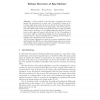Free Online Productivity Tools
i2Speak
i2Symbol
i2OCR
iTex2Img
iWeb2Print
iWeb2Shot
i2Type
iPdf2Split
iPdf2Merge
i2Bopomofo
i2Arabic
i2Style
i2Image
i2PDF
iLatex2Rtf
Sci2ools
131
click to vote
CAIP
1993
Springer
1993
Springer
Robust Recovery of Ego-Motion
A robust method is introduced for computing the camera motion (the ego-motion) in a static scene. The method is based on detecting a single planar surface in the scene directly from image intensities, and computing its 2D motion in the image plane. The detected 2D motion of the planar surface is used to register the images, so that the planar surface appears stationary. The resulting displacement eld for the entire scene in such registered frames is a ected only by the 3D translation of the camera, which is computed by nding the focus-of-expansion in the registered frames. This step is followed by computing the 3D rotation to complete the computation of the ego-motion. This 3D motion computation is based on a motion computation scheme which handles the di cult case when multiple image motions are present. This multiple motion analysis is performed together with object segmentation by using a temporal integration approach.
Related Content
| Added | 09 Aug 2010 |
| Updated | 09 Aug 2010 |
| Type | Conference |
| Year | 1993 |
| Where | CAIP |
| Authors | Michal Irani, Benny Rousso, Shmuel Peleg |
Comments (0)

